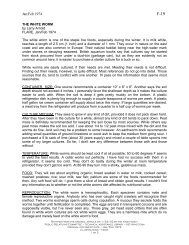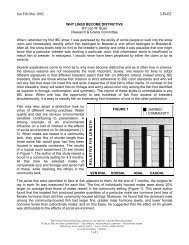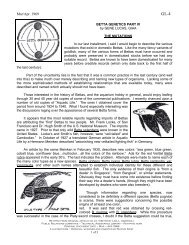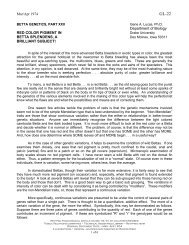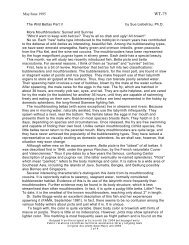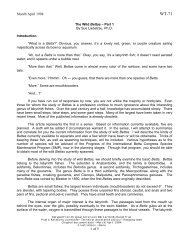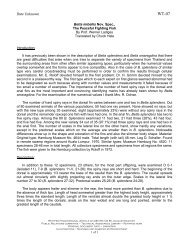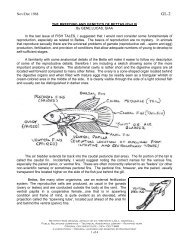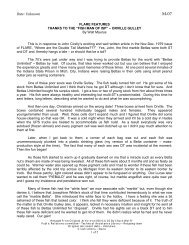CS-11: The Origin of the Marble Betta - International Betta Congress
CS-11: The Origin of the Marble Betta - International Betta Congress
CS-11: The Origin of the Marble Betta - International Betta Congress
You also want an ePaper? Increase the reach of your titles
YUMPU automatically turns print PDFs into web optimized ePapers that Google loves.
Date: Unknown<br />
<strong>CS</strong>-<strong>11</strong><br />
Don't overlook <strong>the</strong> fact that this entire lineage was that <strong>of</strong> standard black, also known as<br />
melano, and carried <strong>the</strong> lethal gene. Whenever line breeding was used, you wound up with<br />
fungused eggs. <strong>The</strong>re was a brick wall. You had to take one or two steps backward, as it were,<br />
to go one step forward.<br />
At <strong>the</strong> 1970 IBC convention held in Cincinnati, Ohio, a wonder appeared. It wasn't at <strong>the</strong><br />
show, but in <strong>the</strong> fish room <strong>of</strong> a guy named Jean Roche. I was unable to obtain any <strong>of</strong> <strong>the</strong><br />
particular fish from him, but Gene Lucas did get some. I owe it to Gene Lucas (as we all do) that<br />
fertile blacks were propagated. I don't know who else may have bred <strong>the</strong>m, but I had thousands.<br />
<strong>The</strong>se fish were different from <strong>the</strong> regular standard blacks in that black fish could be<br />
bred to black fish, and by gosh, you got black fish. Usually. Some <strong>of</strong> <strong>the</strong>m were speckled with<br />
black and o<strong>the</strong>rwise were white (fish flesh colored). <strong>The</strong>se I immediately tagged "marble."<br />
O<strong>the</strong>rs had a greater amount <strong>of</strong> black on <strong>the</strong> body and fins but had white heads, and I named<br />
<strong>the</strong>m "piebald." I swear to this day that until those fish put in an appearance, I had never heard<br />
<strong>the</strong> terms marble or piebald applied to <strong>Betta</strong>s.<br />
Now ano<strong>the</strong>r thing happened. At <strong>the</strong> auction <strong>of</strong> ano<strong>the</strong>r IBC international convention, I<br />
purchased <strong>the</strong> only fish I have ever bought at an auction. It was a male Indonesian fish with<br />
green and yellow fins. It also had a very unique feature- a double caudal. Gene Lucas allowed<br />
me to out bid him on this fish in <strong>the</strong> way that Gene is able to do. I blew a whole five-dollar bill on<br />
<strong>the</strong> first non-red double tail male <strong>Betta</strong> this country had ever seen. Gene knew immediately what<br />
it was, and he let me have it. I owe Gene Lucas many things, and this is one <strong>of</strong> <strong>the</strong>m. (Although<br />
I'll never forgive him for requesting red <strong>Betta</strong>s that were really red, and me sending <strong>the</strong>m to him<br />
by <strong>the</strong> dozen only to find out years later that he was boiling <strong>the</strong>m to get red pigment.)<br />
Now I had ano<strong>the</strong>r cornerstone. Not wasting time, that non-red, green doubletail was<br />
bred to <strong>the</strong> fertile black strain. It began to save a lot <strong>of</strong> time when your first mating produced<br />
what you wanted in plain view. I got doubletailed blacks and doubletailed whites within two<br />
generations, and <strong>the</strong>n it was just a matter <strong>of</strong> cleaning <strong>the</strong>m up <strong>of</strong> iridocytes. <strong>The</strong>re never was<br />
any red, and if <strong>the</strong>re was, it was eliminated by <strong>the</strong> non-red gene with <strong>the</strong> doubletailed<br />
Indonesian obviously displayed.<br />
Now let's go back to several questions that have recently popped up. To differentiate<br />
between a black lace <strong>Betta</strong> and a melano black with <strong>the</strong> opaque factor, we look at <strong>the</strong>m. That<br />
will probably not satisfy you, but that is all you would need to do.<br />
<strong>The</strong> standard black which carried <strong>the</strong> lethal gene did not have any <strong>of</strong> <strong>the</strong> lacy<br />
appearance <strong>of</strong> <strong>the</strong> later fertile black which, on <strong>the</strong> o<strong>the</strong>r hand, almost always displayed that<br />
characteristic. <strong>The</strong> black <strong>of</strong> <strong>the</strong> standard black was usually an even gradation <strong>of</strong> <strong>the</strong> black<br />
coloration. <strong>The</strong> fertile black seemed to have rectangular specks <strong>of</strong> black on clearer fin material.<br />
Basically, <strong>the</strong> standard black was smoked evenly, and <strong>the</strong> fertile black had a lace-like<br />
appearance.<br />
Retyped from original article on 01/22/02 by <strong>the</strong> Page Family<br />
Public Relations Committee ~ technical assistance library ~ retyping team<br />
<strong>Origin</strong>al document date ~ Unknown<br />
Illustrations ~ None<br />
2 <strong>of</strong> 2



